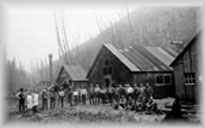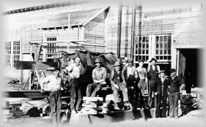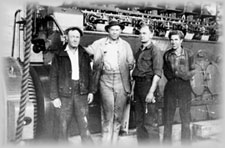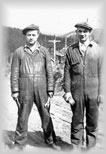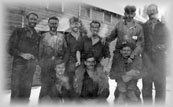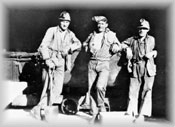 |
|
|

Both Island Mountain Mines and Cariboo Gold Quartz Mining Company were faced with strikes. There were two major strikes causing setbacks in the development and exploration of the mines. Both Island Mountain Mine and Cariboo Gold Quartz Mine went through financial hardship when the miners decided to strike, stopping work in order to demand better pay.
The first mining strike was started by the miners of Island Mountain Mine which closed the mine down from May 15 to August 1, 1937, during a recession. The issue was originally thought to be over seniority, but the real issue was union recognition for the mining employees, pursued on their behalf by the American based Committee for Industrial Organization (C.I.O.).
Employees of Island Mountain Mine... struck last week and preparations were made to close the mine indefinitely... The 118 strikers seek higher wages and recognition of the International Union of Mine, Mill and Smelter Workers...5
Men were fired when they walked off their jobs. Island Mountain Mines closed down, much to the shock of the strikers. The Cariboo Gold Quartz Mine followed suit, closing operations May 25 to July 15. In turn, the Cariboo Gold Quartz Company refused to deal with the C.I.O. or any representatives from outside unions.
By July, the miners were getting angry and bitter over the dispute, with the strike almost slowing the economy of Wells to a standstill. Little strike pay was available, and the strike caused great financial hardship for many families who were forced to seek employment elsewhere or ask for credit to be extended to them from the local merchants.
In the June 26, 1937 issue of the Toronto Financial Post, an article titled Early Settlement Is Seen In Cariboo Strike Areas stated "R. R. Rose, managing director, (of Cariboo Gold Quartz - ed. note) told the men that the mine would be reopened if lOO men would sign an agreement to return to work."
Reportedly within a few hours time 70 signatures were obtained. Work finally resumed by July 15, 1937, with about half the crew. The strike was lost, and basically over by the end of July with very little accomplished. By August, the mines were once again fully operational. There were hard feelings between supporters of the C.I.O. and the people who just wanted to work. Howard Harris, a resident of Barkerville during the strike, mentioned in a conversation with Sandy Mather in March, 1983 "...there was a terrible lot of bitterness afterwards... Yes, it upset that town for quite a while..." The financial loss to the Wells' miners was estimated at $104,000. The mines increased production by the mid 1940s as they were encouraged to do so by the government to provide cash to purchase arms for the Allied cause from the U.S.A. since the Second World War broke out in 19398.
After the best month of production in the history of the Cariboo Gold Quartz Mine in February 1942, the fortunes of the mines rapidly dissolved. Wages were frozen by government regulations and further hiring or mining development was forbidden. Due to rising costs and low prices, the gold mining industry struggled to make a profit. Both mines were affected once again by a second strike in 1946. The Island Mountain Mines Annual Report in 1946 reported 147 strike days in total.
Both mining companies in Wells never did regain their former glory after the effects of these strikes and the Second World War.
The Process | Lode vs. Placer | Two Companies | Mining Strikes | Profile of a Miner | Home | Meet the Team | Site Map
Last updated:September 9, 2000
